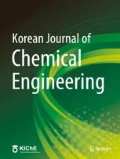Abstract
The dissolved organic carbon (DOC) properties for the influent of the BAC pilot plant have shown a 42% biodegradable fraction and a 58% non-biodegradable fraction. The biodegradable dissolved organic carbon (BDOC) was degraded entirely by biodegradation; the removal efficiency was 65–83%. The BDOC removal efficiency at empty bed contact time (EBCT) 15 minutes was larger than at EBCT 8 minutes. At increasing EBCT, a more slowly biodegradable fraction of BDOC (H2) was utilized. The non-biodegradable dissolved organic carbon (NBDOC) was removed mostly by adsorption, and the removal amount was 24–58%. Therefore, the DOC was removed by adsorption and biodegradation; the removal efficiency by biodegradation was 31%, and that by adsorption was 24%. The breakthrough behaviors of DOC and NBDOC continued to be saturated as the bed volume increased, whereas the BDOC breakthrough curves maintained a certain ratio according to the bed volume.
Similar content being viewed by others
References
Dore, M., Legube, B. and Langlais, B., “Mechanism of the reaction of ozone with soluble aromatic pollutants,”Ozone Sci. Eng.,2, 39 (1980).
Frick, B., Bartz, R., Sontheimer, H. and Digiano, F. A.,Predicting Competitive adsorption effects in granular activated carbon filters, in activated carbon adsorption of organics from the aqueous phase, Vol. 1, I. H. Suffet and M. J. McGuire (Eds). Ann Arbor Science, Ann Arbor, Mich. (1980).
Gilbert, E., “Investigations on the changes of biological degradability of single substances induced by ozonation,”Ozone Sci. Eng.,5, 137 (1983b).
Hubele, C.,Adsorption und biologischer abbau von huminstoffen in aktivkohlefiltern, Diss. Univ. Karlsruhe (1985).
Huck, P. M., Fedorak, P. M. and Anderson, W. B.,Effect of water treatment processes on concentrations of assimilable organic carbon, Proc. 12th Intl. Symp. On Wastewater Treatment; 1st Canadian Workshop on Drinking Water, Montreal (1989).
Janssens, J. G., Meheus, J. and Dirickx, J., “Ozone enhanced biological activated carbon filtration and its effect on organic matter removal and particulate on AOC reduction,”Water Science and Technology,17, 1055 (1985).
Joret, J. C. and Levi, Y.,Method rapide d’evaluation du carbone eliminable des eaux par voie biologique, Trib. Cebedeau (1986).
Kim, D. Y., Lee, S. B. and Rhim, J. A., “A study on the concentrations of biodegradable dissolved organic carbon in the nakdong river water sample and its ozonated samples,”KSEE,15, 717 (1993).
Kim, D. Y., Rhim, J. A., Yoon, J. H. and Lee, S. B., “Characteristics of micropollutants by ozonation and treatment of BDOC in the nakdong river,”Water Supply,14, 285 (1996).
Kim, S. H., Ngo, H. H., Chaudhary, D. S., Kim, J. C., Vigneswaran, S. and Moon, H., “Characterization procedure for adsorption of DOC (dissolved organic carbon) from synthetic wastewater,”Korean J. Chem. Eng.,19, 888 (2002).
Lee, J. E., Choi, W. S. and Lee, J. K., “A study of the bubble properties in the column flotation system,”Korean J. Chem. Eng.,20, 943 (2003).
Lee, J. E. and Lee, J. K., “Effect of microbubbles and particle size on the particle collection in the column flotation,”Korean J. Chem. Eng.,19, 703(2002).
Moon, H., Kwon, H. J. and Park, H. C., “A new characterization procedure for aqueous solution with unknown composition,”Korean J. Chem. Eng.,7, 53 (1990).
Rhim, J. A., “Decomposition characteristics and overall decomposition rate constant of dissolved ozone,”Env. Eng. Res.,25, 1394 (2003).
Rhim, J. A., “Equilibrium concentration and overall Henry’s law constant of the dissolved ozone,”Env. Eng. Res.,9, 49 (2004).
Rhim, J. A. and Yoon, J. H., “Mass transfer characteristics and overall mass transfer coefficient in the ozone contactor,”Korean J. Chem. Eng.,22, 201 (2005).
Rhim, J. A., Yoon, J. H. and Kim, D. Y., “A study on the DOC breakthrough characteristics in biological activated carbon process and DOC adsorption isotherms for regenerated carbon,”KSEE,19, 1455 (1997).
Rhim, J. A., Yoon, J. H., Kim, S. H. and Kim, D. Y., “Sensitivity analysis and applications of plug flow stationary solid phase column model with adsorption and biodegradation in GAC columns,”KSEE,21, 27(1999).
Roberts, P. V. and Summers, R. S., “Performance of granular activated carbon for total organic carbon removal,”AWWA,74, 113 (1984).
Roberts, P. V., Summers, R. S. and Regil, S.,Adsorption techniques in drinking water treatment, EPA-570/9-84-005, U. S. EPA, ODW, Washington, D.C. (1984).
Servais, P., Billen, G. and Hascoet, M. C., “Determining of the biodegradable fraction of dissolved organic matter in water,”Wat. Res.,21, 445(1987).
Servais, P. and Billen, G., Unpublished data (1989).
Somiya, I., Yamada, H., Nozawa, E. and Mohri, M., “Biodegradability and GAC adsorbability of micropollutants by preozonation,”Ozone Sci. Eng.,8, 11(1986).
Sontheimer, H., “Anwendung von verfahrenskombination zur erzielung einer optimalen trinkwasserqualitat,”DVGW Schriftenreihe Wasser,15, 229(1978).
Van Der Kooij, D., Visser, A. and Hijnen, W. A. M., “Determining the concentration of easily assimilable organic carbon in drinking water,”AWWA,74, 540 (1982).
Warner, P. and Hambsch, B., “Investigations on the growth of bacterial in drinking water,”Water Supply,4, 227 (1986).
Author information
Authors and Affiliations
Corresponding author
Rights and permissions
About this article
Cite this article
Rhim, J.A. Characteristics of adsorption and biodegradation of dissolved organic carbon in biological activated carbon pilot plant. Korean J. Chem. Eng. 23, 38–42 (2006). https://doi.org/10.1007/BF02705690
Received:
Accepted:
Issue Date:
DOI: https://doi.org/10.1007/BF02705690




